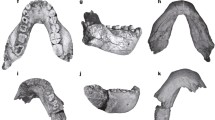Abstract
This brief article calls the attention on the significance for the study of human evolution of the evidence recently uncovered by Dr. L. S. B. Leakey and named by himKenyapithecus. It is argued thatKenyapithecus is best interpreted as a representative of the rich variety of forms characteristic of the hominid (and hominoid) adaptive radiation in Miocene times.Kenyapithecus does not have to be interpreted necessarily as a remote ancestor of man, since some of the features of that form make it difficult to consider it as ancestral to the Australopithecines and since, on the other hand, the many features shared byKenyapithecus andHomo may result from parallel evolution.
Similar content being viewed by others
References
Butler, P.M. &J.R.E. Miles, 1959. A contribution to the odontology ofOreopithecus.Bull. Brit. Mus. N. H., 4: 1–26.
Crusafont-Pairo, M. &J. Huerzeler, 1961. Les Pongidés fossiles d'Espagne.Comptes Rendus Acad. Sc., t. 252: 582–584.
Frisch, J.E., 1965. Trends in the evolution of the hominoid dentition.Bibl. Primat., fasc. 3, Karger, Basel.
Leakey, L.S.B., 1961. A new lower Pliocene fossil primate from Kenya.Ann. Mag. N. H., ser. 13: 689–696.
——, 1967. An early Miocene member of hominidae.Nature, 213: 155–163.
——, 1964. A new species of the genusHomo from Olduvai Gorge.Nature, 202: 7–10.
Patte, E., 1966. De l'importance de l'évolution parallèle dans l'étude de l'origine et de l'évolution de l'homme.L'Anthropologie, 70: 545–552.
Pilbeam, D.R., 1966. Notes onRamapithecus, the earliest known hominid, andDryopithecus.Am. J. Phys. Anthr., n.s. 25: 1–5.
Remane, A., 1956. Paläontologie und Evolution der Primaten, besonders der Nicht-Hominiden. In:Primatologia,Hofer,Schultz, &Starck (eds.) vol. I, pp. 268–378. Karger, Basel.
Robinson, J.T., 1956. The dentition of the Australopithecinae.Mem. Transvaal Mus., 9: 1–179.
--, 1965. Remarks inThe Origin of Man; Symposium distributed by the Wenner-Gren Foundation.
Simons, E.L. &D.R. Pilbeam, 1965. Preliminary revision of the Dryopithecinae (Pongidae, Anthropoidea).Folia Primat., 3(2–3): 81–152.
Washburn, S.L., 1950. The analysis of primate evolution with particular reference to the origin of man.Cold Spring Harbor Sympos. on Quantit. Biology, 15: 67–77.
Author information
Authors and Affiliations
About this article
Cite this article
Frisch, J.E. Remarks on the phyletic position ofKenyapithecus . Primates 8, 121–126 (1967). https://doi.org/10.1007/BF01772156
Received:
Issue Date:
DOI: https://doi.org/10.1007/BF01772156




